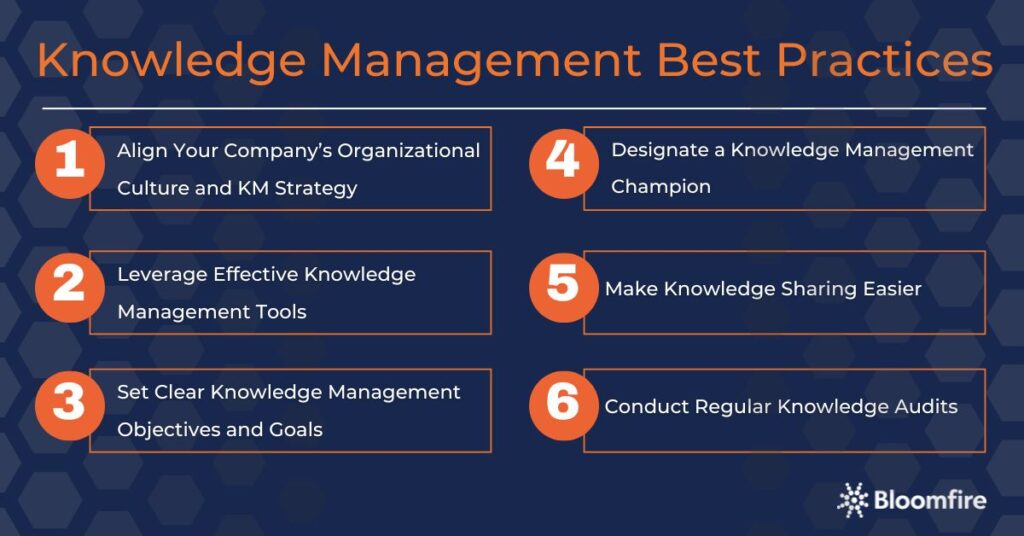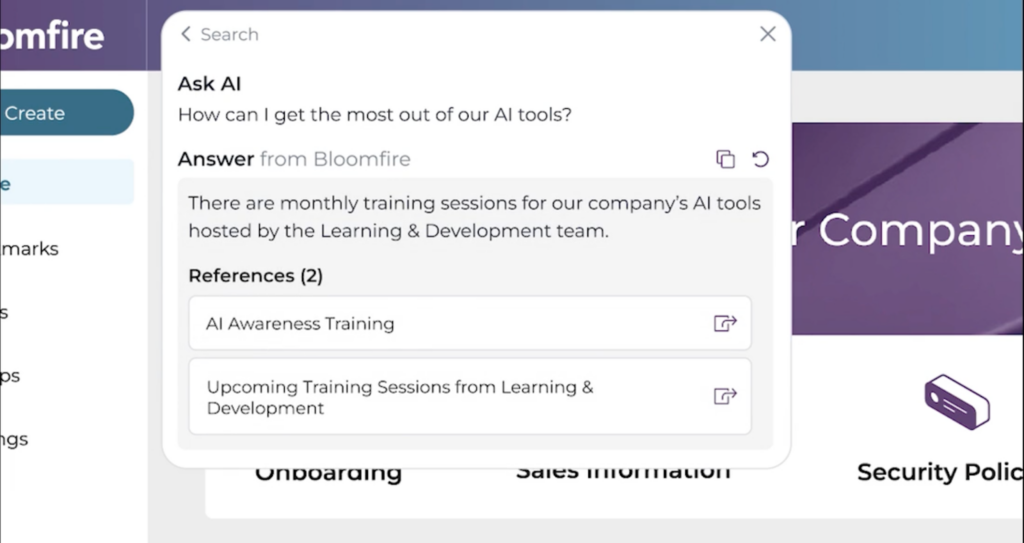6 Knowledge Management Best Practices

Companies that integrated knowledge management (KM) into their internal processes have truly realized its value. However, some may not realize there are better ways to optimize KM in the organization. You may miss out on valuable strategies if you’re not implementing the most up-to-date practices. From aligning your culture and KM approaches to conducting regular audits and designating a champion, here are six of the best knowledge management practices you can adopt.

Power Move: Having reliable knowledge management software to capture and organize insights and information allows for a more streamlined implementation of the best practices in knowledge management. Choose a solution that matches your organizational needs and structure.
1. Align Your Company’s Organizational Culture and KM Strategy
Your organizational culture is an essential component of your business’s operations—and so is your KM strategy. When these two are aligned, knowledge management is significantly more valuable as you can integrate KM tools into your organization without confusion or resistance.
When creating a knowledge management framework, assess employee skills and their existing areas of expertise. Learn how they regularly communicate and collaborate with others throughout the organization. Then, the ownership of specific knowledge management strategies should be defined early, mapping out each role. Communicate with critical players their responsibilities, how to use your KM system, and the overarching organizational goals.
Afterward, support the seamless integration of KM into your culture by encouraging knowledge-sharing. Here are a few ideas to help you get started:
- Create a space that supports knowledge sharing: These can be physical spaces for brainstorming and collaboration in an office. They can also be virtual tools that bring people together to share knowledge if you’re working remotely.
- Offer knowledge-sharing incentives: Give shoutouts in company meetings, tangible prizes, performance review incentives, and clearly defined professional development opportunities.
- Update your training and onboarding procedure: Bake the use of KM in the transition process of new hires into your company culture. Incorporate knowledge management tips like mentorships, job shadowing, and input sharing.
Considering these tactics when planning your knowledge management approach ensures that those involved in the implementation understand its value and advantages. Make it a goal to institutionalize knowledge management best practices in the workplace.
2. Leverage Effective Knowledge Management Tools
A significant part of information management incorporates tools and technologies that enable organizations to create efficiencies in knowledge-sharing environments. This is why choosing the right KM software often bolsters these knowledge management system best practices.
When looking for the best option, search for key features that support knowledge democracy, protection, and existing software integration. For example, if you establish a knowledge base–a library of expert-created content organized online for your organizational use–look for functions that maximize access and sharing.
You can refer to Bloomfire features that promote ease of use, such as:
- AI-powered search: This is the ability of the tool to index and search across a wide range of file types, including words spoken in videos.
- Q&A engine: This refers to the component of the knowledge base that lets team members publish questions and crowdsource answers, as well as make everything searchable, similar to a search engine.
Fully configurable homepage: Admins can use drag-and-drop widgets to control what appears on their homepage without coding. This feature makes adding necessary adjustments to the user experience easy without the steep learning curve.

You can treat your KM software as an in-house search engine with AI assistance.
More often than not, your choice of KM software can help reinforce the other best practices for knowledge management mentioned in this guide. The right tools can influence the comfort level of team members when using your designated KM solution. So choose wisely.
3. Set Clear Knowledge Management Objectives and Goals
43% more likely to achieve your goals if you document and revisit them regularly, as it organizes your entire strategy or plan and gets everybody on the same page. This remains true in knowledge management.
Defined KM goals and objectives ensure you’re creating and sharing the information your teams need to be successful in their roles. It’s a matter of tailoring your knowledge management system’s best practices to their day-to-day functions.
To set a concise and clear direction for your knowledge management system, do the following:
- Establish your big why: State why a KM strategy is essential for your entire organization to retain collective knowledge and insight within the company. This should tie back to specific business goals.
- Define why KM matters: State what KM offers you and your team. Highlight the benefits of a knowledge base, including improved productivity, reduced training time, increased employee engagement, knowledge preservation, consistent communication, empowered remote work, better collaboration, and more.
- Identify your specific KM goals and objectives: Two of the most significant goals you should aim for with your KM strategy are based on your audience: external (customers) and internal (employees). The objectives can also vary within each major category. Externally, these are directed to different buyer journey stages. Internally, your objectives are focused on employees with various responsibilities and degrees of expertise.
- Sort the necessary changes in KM implementation: If you’re implementing a KM strategy for the first time, identify the shift in practices and processes your staff will need to integrate your KM strategy into their daily work life.
Adding clarity to your KM strategy goals is an integral part of your knowledge management best practices in that it drives a better understanding of your decision-making process when incorporating a new system. This is particularly true if your organization is going through several pivots in a specific period, which may involve introducing new software.
4. Designate a Knowledge Management Champion
A knowledge management champion is someone within your organization who acts as a leader in developing, implementing, and maintaining effective KM best practices. The appointed person typically has the required skills, experience, and capacity to drive buy-in for a knowledge management project.
Ideally, you should tap someone who understands how to identify, capture, and store information in a way that is easily accessible to all. Here are just a few responsibilities a knowledge management champion will perform:
- Communicate goals to team members
- Lead the launch of a new KM platform
- Welcome staff to the platform and detail the objectives
- Stay active on the platform
Stationing a reliable leader to execute your knowledge management strategy ensures your plans are implemented accordingly and the metrics are tracked regularly. Additionally, your team members will have someone to consult regarding issues encountered when using KM software.
5. Make Knowledge Sharing Easier
Knowledge sharing (KS) enables information expansion and preservation. After all, what’s the point of gathering all of this incredible talent and information within the company if you’re not sharing it with other team members?
In fact, organizations that preserve unique knowledge and enforce a sharing environment drive employee satisfaction and improved performance. Doing so is a win-win setup for everyone. You support professional development and skills upgrades while expanding your intellectual assets within the company.
Here are some helpful tips for making it as easy as possible for employees to document and share their knowledge:
- Focus on experience first: Look for ways to make it easy and efficient for teams to access and share information (e.g., training, readily available resources, open communication, etc.).
- Create a clear guide for everyone: Establish a playbook for content sharing. Leverage documents the team members already created to save time. This should help you develop answers for frequently asked questions.
- Make templates for different content types: Allow employees to document their knowledge in the format that makes the most sense to them (e.g., recording a screen share video rather than writing a step-by-step text document)
Eliminating complexities and unnecessary steps can promote knowledge-sharing among your teams. Deliberate actions to make the process easy can motivate everyone to adopt a team-player mentality and join the knowledge-sharing culture.
6. Conduct Regular Knowledge Audits
Regular knowledge audits are a common knowledge management practice to map out the knowledge available across your organization, where it is stored, how it is used, what is current or needs to be updated, and what is missing.
Knowledge audits also assess gaps and optimize knowledge assets to make them as valuable as possible to the organization. Although specific steps can vary from company to company, you’ll want to make sure you’re covering these five areas:
- Build your audit team: Your team may include cross-functional members responsible for carrying out your knowledge audit and any next steps.
- Revisit your goals and objectives: Similar to what you do with your business goals, schedule a dedicated time to re-assess the goals and objectives stated in your KM strategic plan. Update and amend when necessary, depending on your business and management conditions.
- Create an inventory of existing organizational knowledge: Examine all types of existing knowledge (e.g., explicit, tacit, and implicit) from different sources, such as surveys, questionnaires, shared drives, your company intranet, and more.
- Review how knowledge is transferred: Determine how your employees access and share information. Also, identify who shares knowledge frequently.
- Identify challenges and knowledge gaps: Beyond the apparent gaps in the implementation, highlight any duplication issues. Scour for similar knowledge assets located in different places and make siloed knowledge more accessible to everyone based on access.
CoSchedule’s 2022 Trend Report on Marketing Strategy revealed that leading marketers were 414% more inclined to report success when they documented and evaluated their strategies. This remains true in knowledge management.
Performing regular knowledge audits leads to essential calibration in the use of KM software and the execution of your own set of knowledge management best practices. Depending on the maturity of your usage, you can schedule quarterly or yearly audits.
Power Move: Companies who encounter these tips often ask, “How do we implement knowledge management best practices?” While this can be done by establishing these recommendations early on and updating them periodically, it’s crucial for your KM champions to get up to speed with the latest trends in knowledge management to further enjoy its benefits.
Applying the Best Practices for Knowledge Management
Taking these knowledge management examples into practice can significantly maximize the benefits of your KM system. By aligning your organizational culture with KM strategies, utilizing the right tools, and setting clear objectives, you can create a more efficient and knowledgeable workplace that empowers employees to share insights and expertise. More importantly, a KM platform can accommodate a wealth of information with navigational features that defeat waiting time and storage issues.
This blog post was originally published on February 8, 2023. It was updated and expanded in December 2024 to reflect new information and best practices.
Optimize Your Team’s Knowledge Sharing
Dive deeper into knowledge management best practices in our comprehensive guide.
Learn More

Enterprise AI Search: Definition, Benefits, and Evolution

The Benefit of Company-Wide Knowledge Management in 2026

Are You Making These Common Knowledge Sharing Mistakes?

Estimate the Value of Your Knowledge Assets
Use this calculator to see how enterprise intelligence can impact your bottom line. Choose areas of focus, and see tailored calculations that will give you a tangible ROI.

Take a self guided Tour
See Bloomfire in action across several potential configurations. Imagine the potential of your team when they stop searching and start finding critical knowledge.